Exploring Colorado's Front Range
RV travel to Central City, Mount Evans and Idaho Springs
Article Date: January, 2014
Article and Photography by Mark Quasius
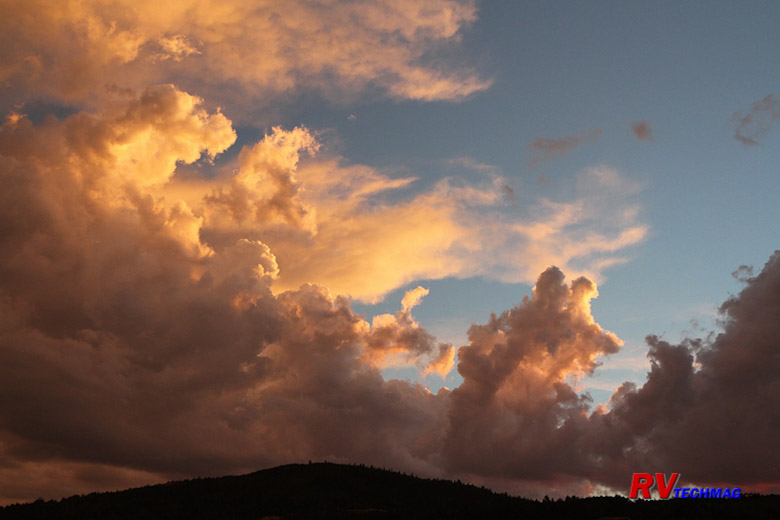
Travelers heading west from Denver are treated to one of the country's most scenic drives as Interstate 70 leaves the lower
elevations of the Mile High City and winds its way through valleys and steep grades towards Loveland Pass at 11,880' of altitude. Shortly after
leaving Denver via a brief climb the road drops down into a beautiful valley at Idaho Springs, a former mining town turned into a popular tourist
stop. Idaho Springs also serves as the gateway to Mount Evans and the Mount Evans Scenic Highway begins its climb to the 14,265' summit. The Central
City Parkway begins here as well and takes travelers over a steep mountain grade to the Central City and Blackhawk mining districts, which are now
frequented by casino players rather than prospectors and pack mules. Further to the west, Georgetown begins the climb to the Eisenhower Tunnel, which
bores through the highest peaks of the Rockies at around 11,000', bypassing the long winding trip over Loveland Pass in the process. This entire area
is laced with plenty of scenic beauty as well as history.
Central City
Central City was originally founded in 1859 during the Pike's Peak Gold Rush and became known as "The Richest Square Mile on
Earth". As many as 10,000 prospectors worked the area but this boom was short lived when the miners eventually moved to other locations. By the 1950s
only a few hundred remained and when Casino gambling was introduced in the 1990s the town experienced a slight resurgence and the 2000 census showed
Central City's population at 515. To provide a direct route to town, the Central City Parkway was completed in 2004. This road climbs the steep grades
from Idaho Springs to Central City but is wide and modern and is suitable for large RVs. An ideal base camp for any RV traveler is the Central City KOA,
which is one of the better KOAs in the country. It is situated up a winding drive but overlooks Central City from its lofty perch and provides some
amazing sunsets as the sun sets over the Front Range.
|

Central City has been revived into a tourist center and large casino complex.
|
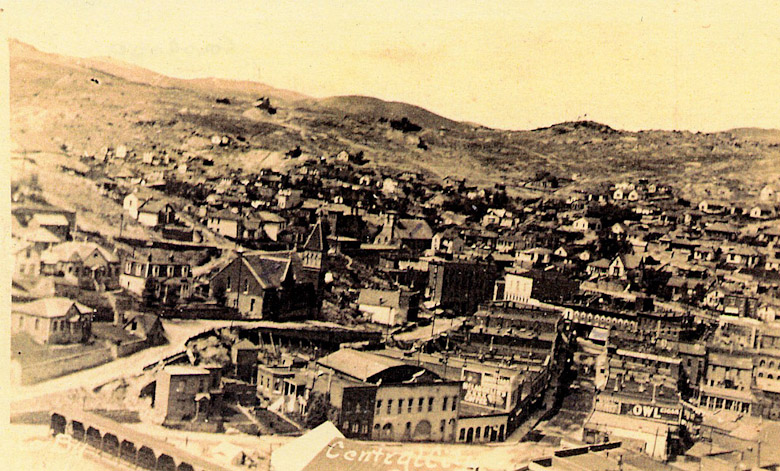
In the 1800's Central City was a booming mining town, complete with saloons, opera houses and mining related businesses.
|
|
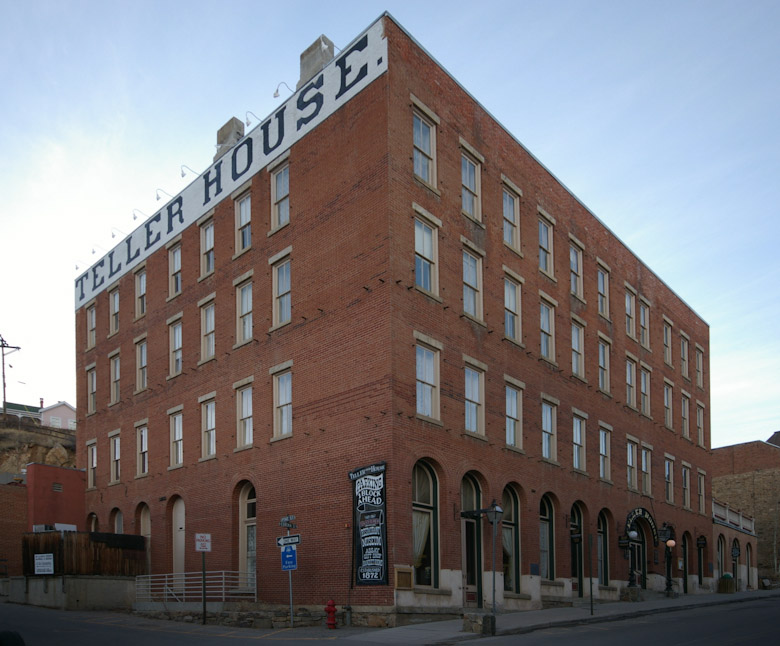
The Teller House still hosts operas today, just as it did over a century ago.
|
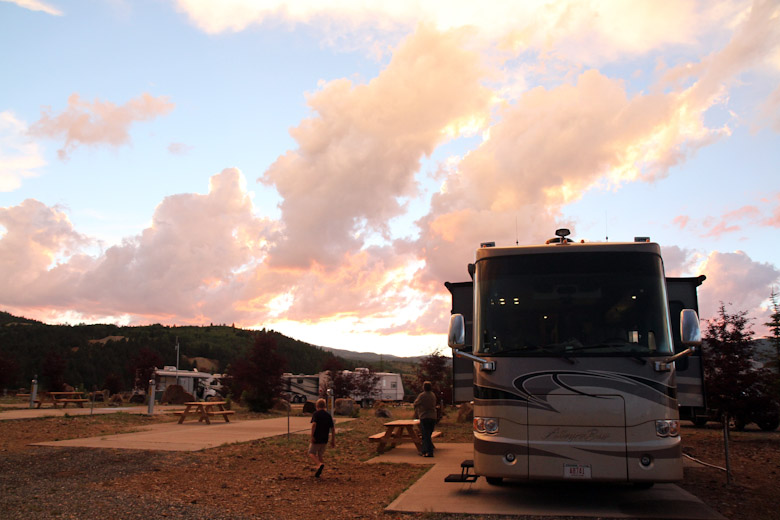
The Central City KOA is the perfect place to stay and enjoy the sunset while exploring the area.
|
Idaho Springs
Idaho Springs is placed right alongside Interstate 70 and anyone traveling west of Denver can easily see the town from the
interstate, which is raised to squeeze alongside the southern edge of town. Legend has it that the town's name was derived from annual visits to the
hot springs each year by a Native American chief who journeyed from Idaho to bathe in the magic healing waters of the natural hot springs there.
Idaho Springs was founded in 1859 during the Pike's Peak Gold Rush in a roundabout way. On January 5, 1859 prospector George Jackson discovered gold
where Chicago Creek empties into Clear Creek. He was originally drawn to the area because of clouds of steam rising from the hot springs. He kept it
a secret but after he paid for his supplies with gold dust the secret was out and other prospectors rushed in to establish their placer claims.
Eventually gold veins were also found in the canyon walls on both sides of Clear Creek and the switch to hard rock mining took place. Idaho Springs
became the main center for the region's mining activities.
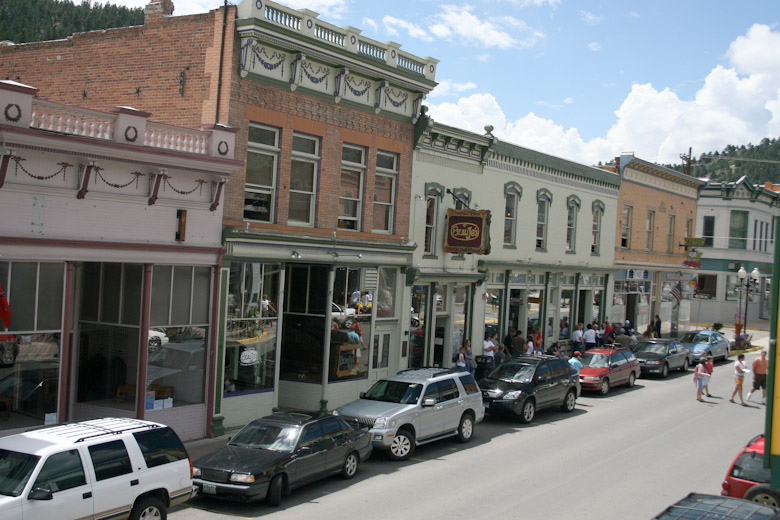
Downtown Idaho Springs is a throwback to
the mining past. Many of the buildings that once served the mining industry have been restored and
used as restaurants or shopping.
Today, downtown Idaho Springs is a National Historical District. Tourism has replaced mining as the driving economic force.
Tours of the Argo Gold Mine and Mill are one of the popular attractions. The local museum features many exhibits on the early mining history of the
area as well as outside exhibits, such as the Charlie Taylor Water Wheel, built in 1893 to power a stamp mill. A walking tour of the area explores a
multitude of historical buildings. Many of the downtown buildings that once served a bustling mining community now house shops and eating establishments.
Undoubtedly the most popular place to dine is Beau Jo's Pizza, which is located in an old general store and mining supply warehouse on downtown Miner's
Street. Their legendary Mountain Pies are a favorite with everyone and draw folks from all over so be sure to arrive early, especially on weekends.
|
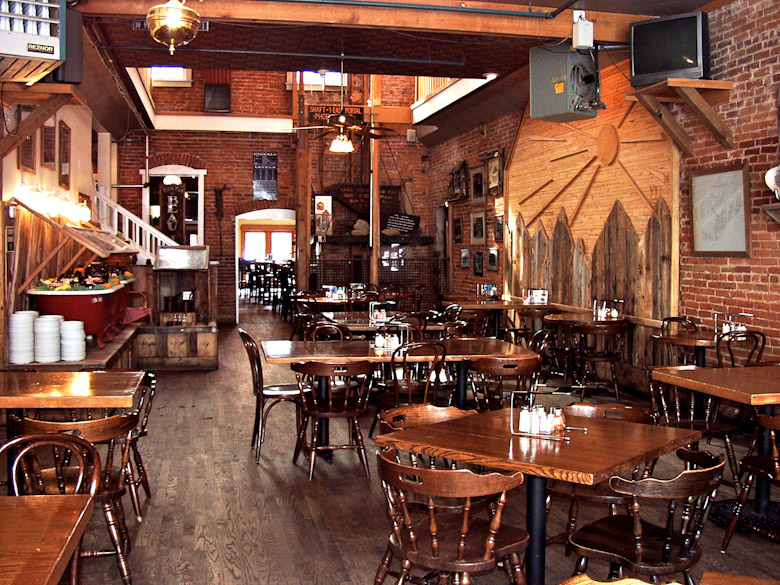
A popular stop in Idaho Springs is Beau Jo's Pizza. You will dine in a restored general store, replete with artifacts from the golden
days of mining.
|

Beau Jo's is notorious for their Mountain Pies, which have been featured on national television. A stop here is the perfect end to a
day of hiking the Rockies.
|
Mines, such as the Argo Mine and Mill, offer guided tours. For those travelers who want to try their hand at mining or panning,
the Phoenix Mine offers gold panning as well as tours. The stream runs right alongside the road and picks up gold in the mountains above and carries
it downstream. Best of all, you can keep any gold that you find.
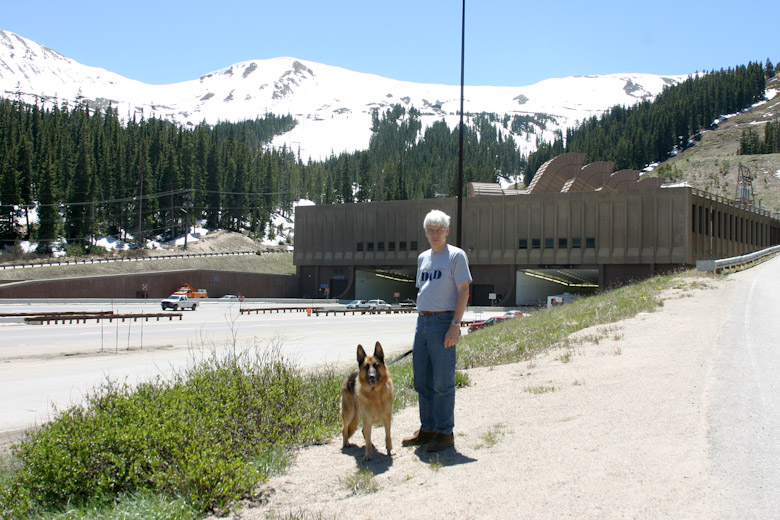
Located at over 11,000', the Eisenhower Tunnel bridges Idaho Springs and Georgetown to Vail and Glenwood Springs to the west, bypassing
Loveland Pass.
Just 8 miles to the west of Idaho Springs lies Georgetown, a former silver mining camp alongside Clear Creek. Silver was found
in 1854 in nearby Argentine Pass and the town served as a center of commerce for the thousands of mines in the surrounding area. It was even considered
as a possible site for the state capital until the silver boom collapsed in 1893. In the 1950s it began a transformation into a stopover place for skiers
traveling between Denver and the ski resorts of Loveland Pass. The Victorian architecture of the historic downtown area was the setting for the 1986
movie The Christmas Gift, starring John Denver. Today Georgetown is a popular tourist stop and is the location of the Georgetown Loop Railroad, a 19th
century steam engine train ride overlooking the fantastic scenery and old mines between Georgetown and Silver Plume.
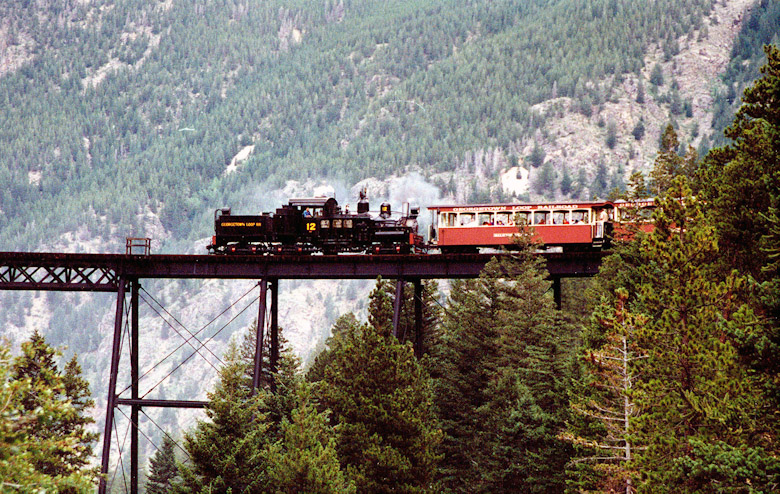
The Georgetown Loop Railroad takes passengers on a steam-powered tour past the gold mines of Clear Creek Canyon.
Mount Evans
Idaho Springs is the beginning of the Mount Evans Scenic Highway, which is the highest paved road in North America that
rises to the summit of Mount Evans at 14,265' of altitude. It is the closest "fourteener" to Denver and actually is 154' taller than Pike's Peak. It
was originally built by the Denver Mountain Parks system to compete for the Pike's Peak tourism dollars that were going to Colorado Springs. The
first stage was to link Echo Lake and Summit Lake to Bergen Park near Evergreen and Idaho Springs. The 13 mile stretch between Echo Lake and Idaho
Springs was completed by 1921 but the final 15 miles to the summit weren't completed until 1930 due to the unusual problems of construction at high
altitudes. In fact, the final 600' were completed by hand.
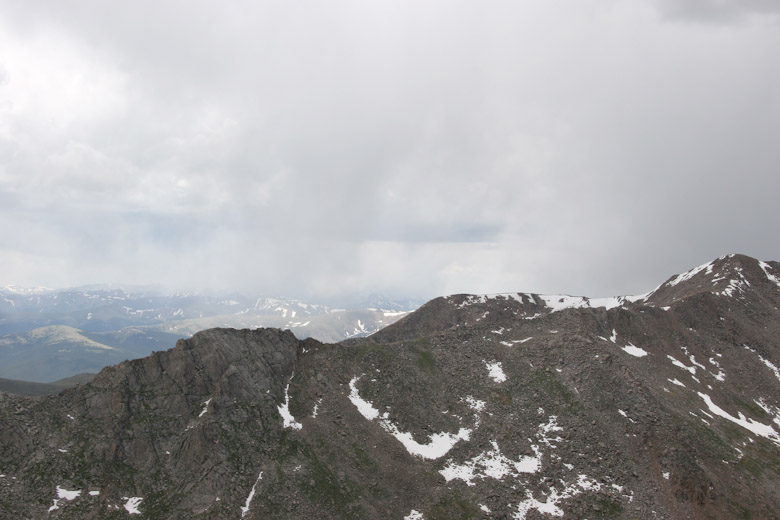
At 14,270', the summit of Mount Evans offers an awe-inspiring view of the Front Range.
This 28 mile drive to the summit passes by amazing scenic views as the terrain changes from montane forests to alpine tundra on
its winding path to the top, gaining over 7,000' of altitude. As you leave Idaho Springs the road begins its gradual climb through lodgepole pine and
blue spruce forests as the buildings and developments alongside the highway gradually disappear. Numerous mountain streams can be seen cascading down
the slopes of the mountain heading for the valley below as you travel the highway. Patches of quaking aspen appear as you approach the subalpine forest
near the Mount Goliath Natural Area, just below Echo Lake. At this nature center you'll begin to see Bristlecone Pine trees. These twisted conifers grow
slowly due to the short season and are battered by the high winds and heavy snow cover. But they are sturdy and some are over 1,600 years old.
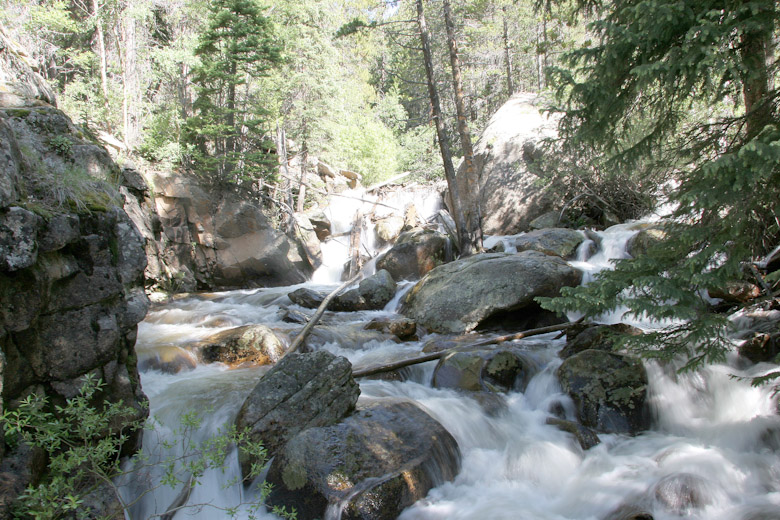
Numerous streams cascade down the mountain slopes.
Echo Lake is located at 11,000' of altitude and is the location of Echo Lake Lodge, which overlooks this scenic mountain lake.
A picnic area is located on the lake's shore and a US Forest Service campground is located next to the lodge. The road up to the summit is gated and
operated by the forest service. Due to the heavy snow loads and long winters at this altitude the road is closed over winter but generally is open
between Memorial Day and Labor Day, although the actual dates are weather dependent. This road is steep and climbs the switchbacks as it winds its
way to the top. RV travel is okay up to Echo Lake but after that the road is fine for passenger vehicles but not suitable for RV travel. In many
places there are steep drop-offs and no guardrails exist so travel will be slow.
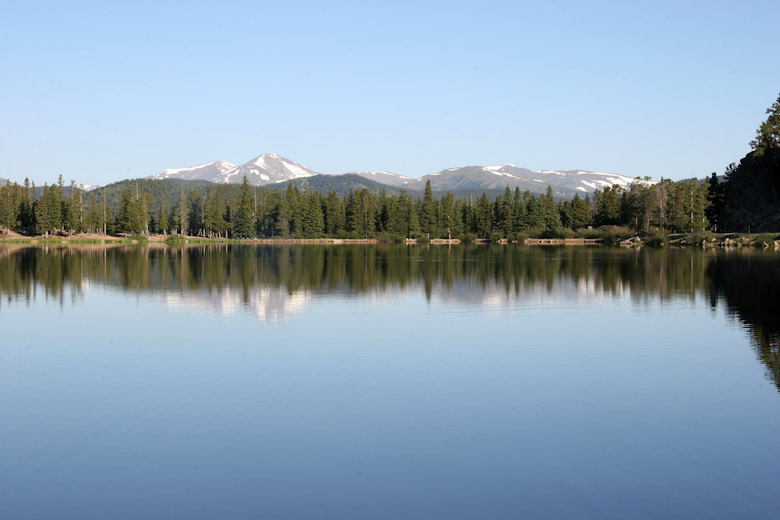
Echo Lake rests at 11,000' on the road to Mount Evans. Echo Lake Lodge, a county park with picnic facilities and a US Forest Service campground
are all located here.
On your way to the summit you'll undoubtedly see Mountain Goats in the rocky meadows alongside the road grazing on the spare
grass and looking for salt deposits. Rocky Mountain Bighorn Sheep can be seen close to the summit and Yellow Bellied Marmots are always a favorite as
is the ever elusive Pika. Crest House was built at the summit in 1941 and served as a restaurant and gift shop until it burnt down on September 1, 1979.
Its remaining rock walls now remain as a windbreak for travelers. The summit has rest rooms as well as a large paved parking area. The commanding
views from the viewing platform at the summit are unparalleled and on a haze free evening the lights of Denver can be seen over 30 miles away as the
crow flies.
|
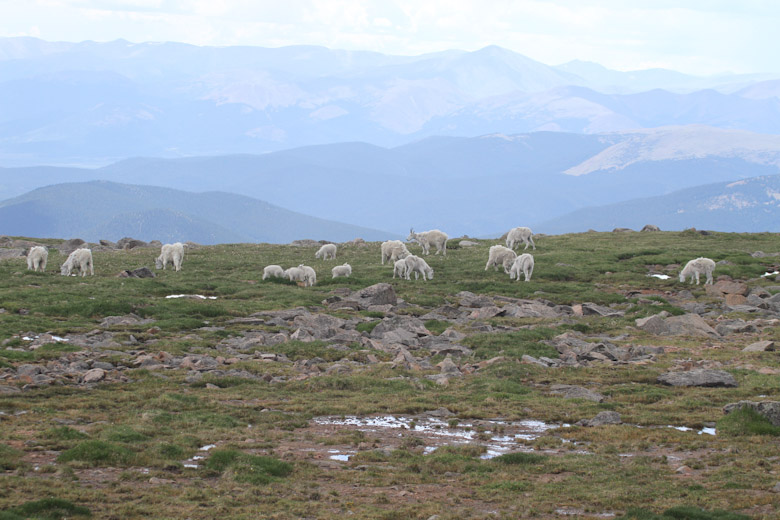
On the high, rocky meadows of Mount Evans, mountain goats can be found grazing and looking for salt deposits.
|
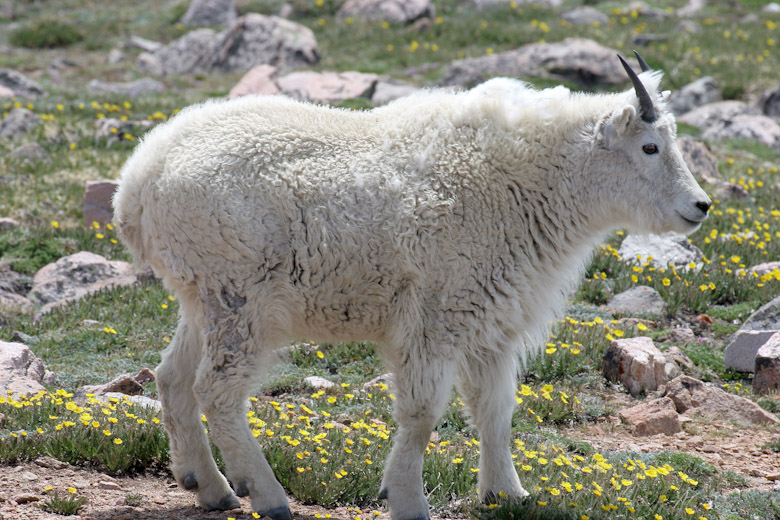
Mountain goats retain their winter coats well into early summer due to the cool temperatures at these higher altitudes.
|
|
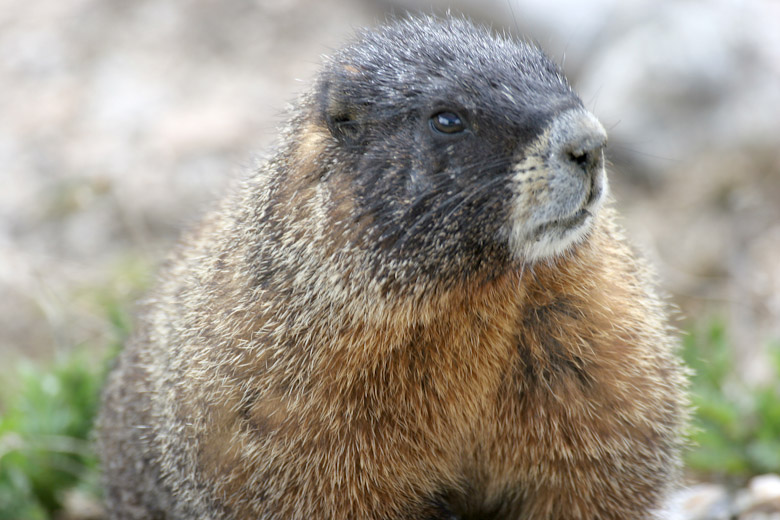
Yellow-bellied marmots, which are related to woodchucks, live in the rocky shale in the higher levels of Mount Evans.
|
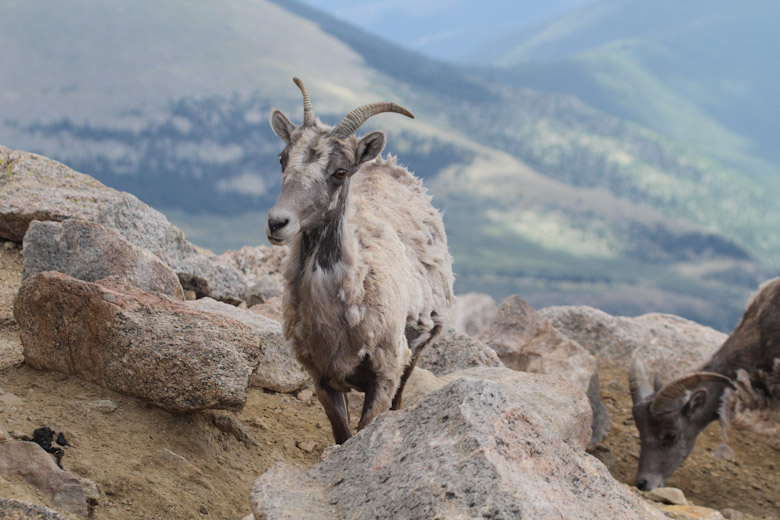
Rocky Mountain bighorn sheep are commonly seen at the summit of Mount Evans.
|
Visitors to Mount Evans should be prepared. Rest rooms are located at Summit Lake, halfway up the mountain, as well as at the
viewing platform at the summit. The air is thin at this altitude so dehydration and altitude sickness can have serious consequences. Bring plenty of
water to prevent dehydration and avoid strenuous activities at the summit, which can bring on disorientation and headaches or dizziness. Be prepared
for changes in weather as well. It may be 90 degrees in Denver but only 40 degrees at the top of Mount Evans. Bring warm jackets or layer your clothing.
On the way down be sure to stop at Echo Lake Lodge for a burger or some homemade pie as well as an "I made it to the top" souvenir.
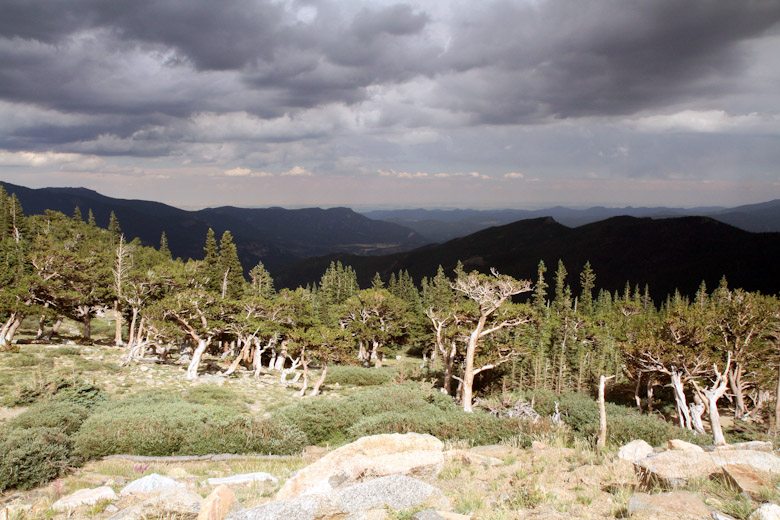
In the higher elevations, the constant winds warp bristlecone pines into twisted shapes. The harsh winters only allow for an extremely short growing
season. These trees have a minute rate of growth and can be over one thousand years old.
Source
Return to Home Page
If you enjoyed this article be sure to recommend RVtechMag.com to your friends, like us on Facebook or Twitter
or subscribe to our RSS feed.



|






















